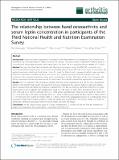| dc.description.abstract | Introduction: Leptin has been suspected to contribute to the development of osteoarthritis (OA). However, this hypothesis has not been tested in large-scale hand OA cohorts. Our study aimed to determine whether there is a cross-sectional relationship between serum leptin levels and hand OA in a population-based sample of US adults. Method: We used the Third National Health and Nutrition Examination Survey (NHANES III), a national cross-sectional population-based survey, to study the relationship between hand OA and serum leptin concentration. We applied previously established classification criteria for hand OA. Patients with rheumatoid arthritis were excluded. Potential confounders included sex, body mass index, the presence of polyarticular OA, diabetes, and total cholesterol. We estimated unadjusted mean leptin concentration by hand OA status and by all confounders. We further developed a linear regression model to assess mean leptin levels, adjusted for appropriate confounders. Results: Of 2,477 subjects in the NHANES III sample that had a hand examination and did not have rheumatoid arthritis, 1,056 (42.6%) had a leptin measurement and were included in the analysis. Subjects with and without leptin measurement had similar demographic characteristics. We did not find any significant differences in mean serum leptin levels in subjects with symptomatic hand OA (7.38 ng/ml in males (95% confidence interval (CI) = 5.31, 9.46) and 21.55 ng/ml in females (95% CI = 17.08, 26.02)), asymptomatic hand OA (6.69 ng/ml in males (95% CI = 5.19, 8.18) and 17.09 ng/ml in females (95% CI = 15.00, 19.18)), and no hand OA (8.22 ng/ml in males (95% CI = 7.47, 8.97) and 20.77 ng/ml in females (95% CI = 18.01, 23.53)) in the unadjusted analysis. In a multivariable linear regression model that included variables of hand OA status, age, race/ethnicity, and obesity status, we found no statistically significant association between serum leptin and hand OA status. Conclusions: In this cross-sectional study of a large representative US cohort, we did not find any evidence to support the hypothesis that serum leptin is associated with hand OA. | en_US |


